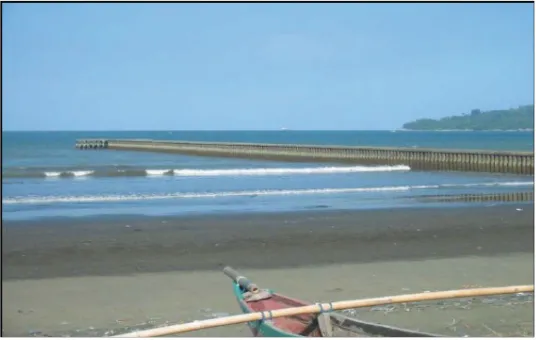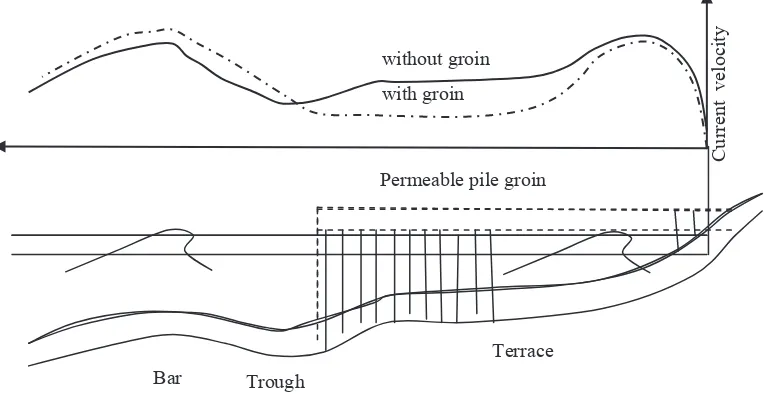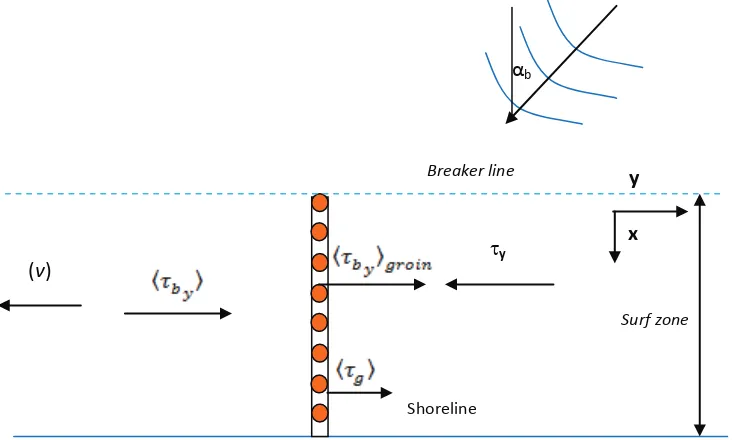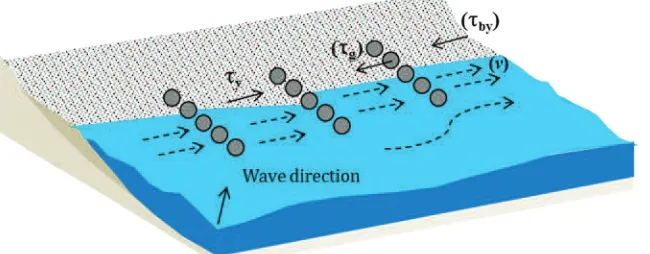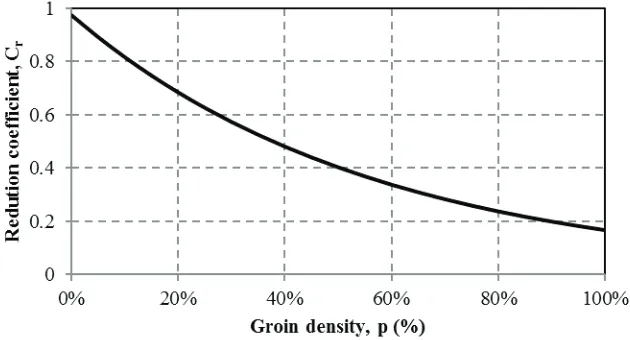THEORETICAL APPROACH OF LONG SHORE
CURRENT REDUCTION COEFFICIENT
THROUGH PERMEABLE GROIN
Hasdinar Umar1*, Nur Yuwono2, Radianta Triatmadja2, and Nizam2
1Coastal Engineering Department, Universitas Hasanuddin
2 Civil and EnvironmentalEngineering Department, Universitas Gajah Mada
*Email: hasdinar.umar@gmail.com; Phone: +62812-2760-8658
Abstract
Permeable groin is a coastal protection structure that is flexible and effective to
control the longshore current and hence longshore sediment transport. The ability to reduce both longshore currents and longshore sediment transport to a desired
extent can provide more control to avoid unwanted sudden changes of shoreline in
particular area.
The average longshore current velocity (v) through permeable groins can be developed theoretically based on Longuet-Higgins, 1970 equation by incorporating
structure parameters of permeable groin namely the distance between the piles (p),
diameter of the pile (dt), and number of the groin (n). Reduction coefficient (Cr)
may be determined by comparison between longshore current through permeable
groin (<v>groin) and longshore current without permeable groin (<v>without groin).
The results showed that reduction coefficient (Cr) may be determined by
, where the reduction coefficient (Cr) describes the magnitude
of longshore currents reduction passing through the permeable groin.
Keywords: permeable groin, longshore current, current reduction coefficient
INTRODUCTION
General Background
longshore sediment transport. The ability to reduce both longshore currents and
longshore sediment transport to a desired extent can provide more control to avoid unwanted sudden changes of shoreline in particular area.
Figure 1. Permeable groin at Teluk Penyu Coast, Cilacap
Design of permeable groins, especially pile groin requires basic theory in order to obtain results that support an effective design which is the reduction coefficient
(Cr) longshore current after the permeable groins.
Permeable Groin
Permeable groins have a porous structure that still allows the current through the structure so that the transport of sediment to the down drift groin could still occurred.
Longshore current and longshore sediment transport basically is controlled by
density of pile groin (p). Several researches related to permeable groin were done
by Hasdinar, et.al, (2011); Abdellah and Balah, (2001); Raudkivi, (1996); which were Hasdinar, et.al, (2011) studied the longshore current after permeable groin. Abdellah and Balah, (2001) has conducted research on the application of permeable pile groins as a coastal protection at Northwestern tourist beach, Egypt. Raudkivi, (1996) studied the application of permeable pile groin at the Baltic Sea coast.
Permeable pile groin structure can reduce longshore current and longshore sediment
density of pile groin ( groin were done by
which were shore current after
on of coastal protection at Northwestern
studied the application of permeable pile groin
while still providing of sediment
thedown driftgroin.
Scheme of beach profile with permeable pile groins and current velocity without groins and with the groin
n this research was analytical the formula of
longshore current reduction coefficient through permeable groin. To derivate the reduction coefficient, two parameters were used. First, the longshore current without permeable groin and second the longshore current with permeable groin. Longshore current formula without permeable groin was derivate from
Higgins, 1970, which were used two parameters,
Figure 2. Scheme of beach profile with permeable pile groins and current velocity distribution without groins and with the groin (Raudkivi, 1996)
Methodology of Study
Method used in this research was analytical study regarding the formula of longshore current reduction coefficient through permeable groin. To derivate the reduction coefficient, two parameters were used. First, the longshore current without permeable groin and second the longshore current with permeable groin. Longshore current formula without permeable groin was derivate from Longuet Higgins, (1970), which were used two parameters, bottom shear stress and shear stress due to wave. Longshore current velocity with permeable groins was derived by assuming that the shear stress will increase as a result of shear stress due to groin piles. So that the longshore current velocity after a permeable groins will be using three parameters: the shear stress due to waves, bottom shear stress and shear stress
due to piles groin.
RESULTS AND DISCUSSION
Longshore Current without Permeable Groin
1. Review of the waves approaching the shoreline
... (1)
2. Radiation stress theory
... (2)
3. Shear stress due to waves
... (3)
4. Bottom shear stress
... (4)
Longshore current analysis without permeable groin developed by Longuet-Higgins, (1970) using the assumption that the current is two-dimensional (no variation in the
vertical direction), steady and uniform in the y direction, so that the momentum
equation in the direction along the shore (longshore direction) using the equation,
... (5)
where
vt : mixed coefficient (eddy coefficient),
‹
v› : longshore current velocity,
τy : shear stress due to waves,
‹
τb y›
: bottom shear stress.Completion of the longshore current equation simplified by ignoring the shear stress
due to turbulence so that the second term in Equation (5) can be neglected by the
wave, making the shear stress due to waves (τy ) is only offset by the average value
of shear stress
‹
τby›
.τy =
‹
τb y›
... (6)If Equation (3) and (4) are substituted into Equation (6), then the longshore current equation of the conditions unhindered groin (Longuet-Higgins, 1970) as follows,
where , so that Equation (7) as a function of breaking wave
height (Hb) can be written as follows,
... (8)
If we assume that the shallow-water theory is applied, then the average of longshore current equation without the influence of lateral mixing can be written as,
... (9)
where,
... (10)
where
Cf : bottom friction coefficient,
Hb : wave height (m)
hb : breaking wave depth (m),
tan β : beach slope,
ab : breaking wave angle.
Hasdinar, 2012 used a no sinusoidal wave assumption of the orbital velocity which derived from mean orbital velocity equation written in Dean and Dalrymple, (1984).
... (11) So that the shear stress direction y (longshore direction) become,
... (12) Hence, longshore current equation can be simplified as,
... (13)
where
um : orbital maximum velocity (m/det),
tan β : beach slope,
Figure 3. Longshore current without groin
LongShore Current with Permeable Groin
Development of longshore current equations with permeable groin based on the direction of longshore momentum equation without the influence of lateral mixing (Equation (10), Longuet-Higgins, 1970), with the basic assumption that the friction increased by the existence of permeable pile groins structure,
... (14)
where is shear stress due to permeable groin barrier that is a function of
the mean shear stress (shear stress between the water and the bottom) ( )
added the average shear stress between water and piles of groins ( ),
... (15)
Shear stress between water and piles of groins ( ) is considered equal to the
drag force of permeable groins (Fd) per unit area constraining groin area.
Total shear stress equation after the barrier of permeable pile groins can be written as follows,
... (17) Longshore current velocity equation through the permeable pile groins developed
from the momentum equation y direction (parallel to the shoreline) after the groins,
as shown in Figure 4, which illustrates that there is a balance between the shear
stress due to waves (ty) and the average shear stress due the permeable pile groin
groin (
<
tby
>
groin).αb
Surf zone
Shoreline Breaker line
ty
y
x
(v)
Figure 4. Sketch of longshore current parameters after a permeable groin
ty =
<
tby
>
groin ... (18)where
<
tby
>
groin is the average shear stress due the permeable pile groin as a functionof the average shear stress (shear stress between the water and the bottom) (
<
tby
>
)added the average shear stress between the water and the pile of groins (
<
tg>
),If Equation (3) and Equation (20) is substituted into (18), the longshore current velocity equation through permeable groins structure can be written as follows,
... (21)
where
p : density of the groin (%),
hr : the average depth of the submerged groin piles (m),
dt : diameter of pile (m).
Cd : drag coefficient
Figure 5. Longshore current with permeable groin
Reduction Coefficient
Once known the magnitude of the average longshore current velocity after the groins then reduction coefficient can be determined. Longshore current velocity
reduction coefficient (Cr) is the ratio between the longshore current velocity after
groins ((v)groin) with longshore current velocity without groins ((v)without groin)). ... (22)
If the beach is used permeable pile groins as shoreline protection, then the magnitude of the longshore current coefficient reduction will be influenced by two roughness
parameters, bottom roughness coefficient (Cf) and drag coefficient (Cd). Based on
Equation (13) and (21), reduction coefficient (Cr) equation can be written as follows,
If known π = 3.14 and g = 0.78, then Equation (23) can be written as follows,
... (24)
Relationship between the reduction coefficient (Cr) and groin density (p) is shown
in Figure 6.
Figure 6. The relationship between the reduction
coefficient (Cr) and groin density (p)
CONCLUSION AND RECOMMENDATION
Based on longshore current reduction coefficient, which is analytically calculated after the permeable groin (Equation (23) and (24)), the followings are the conclusions:
5. Longshore current reduction coefficient is influenced by two roughness
parameters, bottom roughness coefficient (Cf) and drag coefficient (Cd).
Besides the reduction coefficient is also influenced by groin structure
parameters as density of groin (p) and diameter of pile (dt)
6. Finally a relationship of reduction coefficient (Cr) with a groin density (p)
may be constructed and is expected to be useful for designing a permeable groin that is more adaptable to the requirements of shore protection or reduction of longshore current and longshore sediment transport.
ACKNOWLEDGEMENTS
REFERENCES
Abdellah and Balah, 2001. Application of Permeable Groins On Tourist Shore
Protection, Presented in 4th Inter. Symp. On ocean wave measurement and analysis, ASCE, San Francisco, California, USA, Sep. 3-5.
Dominic Reeve, Andrew Chadwick and Christopher Fleming, 2004, Coastal
Engineering, Processes, Theory and Design Practice, pp.56-66, Spoon
Press, New York.
Dean dan Dalrymple, 2002, Coastal Processes with Engineering Applications, Cambridge University Press, USA.
Dean dan Dalrymple, 1984,Water Wave Mechanics for Engineers and Scientists,
Prentice Hall, Inc., Englewood Cliffs, New Jersey 07632.
Elfiky, dkk, 2003, Pile Breakwater as Semi-Transparent Measure for Sea Defence,
Coastal Engineering, Elsevier, Science Direct.
Hasdinar, et.al, 2011, The Influence of Permeable Groin on Longshore
Current, Proceedings of International Conference on Water Related Risk Management, Jakarta, Indonesia, pp. 215-222
Hasdinar, 2012, Study of Permeable Pile Groin Structure Parameters to Control
Longshore Current, Dissertation of Ph.D Program, Department of Civil Engineering and Environmental Engineering, Gadjah Mada University,
Yogyakarta
Longuet-Higgins, 1970, Longshore Currents Generated by Obliquely Incident Sea
Waves,1, Journal of Geophysical Research, Vol.75, No. 33, 20 November 1970.
Longuet-Higgins, 1970, Longshore Currents Generated by Obliquely Incident Sea
Waves,2, Journal of Geophysical Research, Vol.75, No. 33, 20 November 1970.
Longuet-Higgins and Stewart, 1964, Radiation stresses in water waves; a physical
discussion, with applications, Deep Sea Research, Vol. 11, pp 529 to 562:
Pergamon Press Ltd. Printed in Great Britain. Nizam, 1994, Coastal Processes, Lecture note.
Raudkivi, 1996, Permeable Pile Groin, Journal of Waterway, Port, Coastal, and Ocean Engineering, ASCE.
Yuwono N., 1992, Dasar-dasar Perencanaan Bangunan Pantai, Laboratorium
